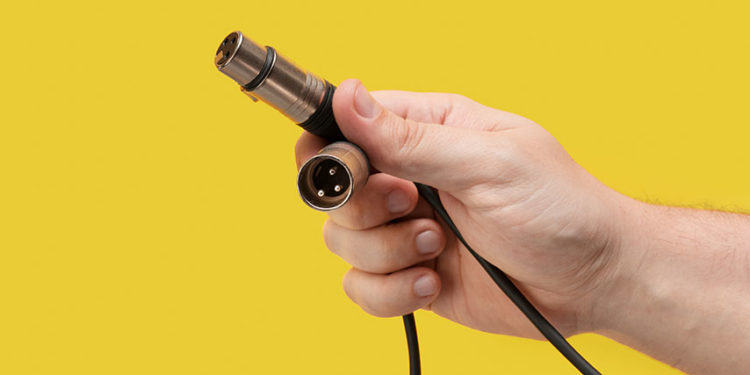
If you’ve ever had a professional XLR microphone and wanted it to plug it into a computer so you can record instantly, you know the dilemma. There are myriad XLR to USB adapters and not each one of them will work for every microphone. In this list, we’ll go over some of the best XLR to USB microphone adapters, XLR to USB converters, and XLR-USB preamps, and the use cases where they’re most appropriate.
Best USB to XLR Cables, Adapters, Converters & Preamps
Hosongin 10 ft USB Male to XLR Female Microphone Cable
This is a simple XLR to USB cable but take note: it will not work with every XLR microphone on the planet. At first glance with an XLR female connector on one end and a male USB plug on the other, it looks like all you’d need to connect a professional XLR microphone to your Mac or PC. But in reality, this XLR to USB cable does not include a preamp, meaning it doesn’t provide power to microphones that need it, as most condenser microphones do. But if you have a dynamic microphone (examples here), then this cable should be all you need. For those with condenser microphones (examples here), read on to the other XLR to USB converters in this list!
This cable is compatible with Mac OS X, Windows 2000, XP, Vista, 7, & 8, as well as PS2, PS3, Wii, and Xbox systems.
Polsen XLR to USB Mic Converter/Mic Preamp
If you don’t have a dynamic microphone (or one that has its own battery inside it) then you’ll need a microphone preamp built into your XLR to USB adapter.
When it comes to XLR to USB preamps, this is about as simple and basic as you can get: it provides 48 v phantom power to condenser microphones via XLR cable (not included) and allows you to plug in a supplied USB cable into your computer from the other end. If you need more frills, keep on reading this list for the next option.
Shure X2U XLR-to-USB Signal Adapter
Shure makes a multitude of pro headphones and microphones so it’s no surprise that they make XLR to USB adapters too. The Shure X2U adapter accepts an XLR input on one and and a USB output on the other. In between, the adapter provides you with a microphone port for confidence monitoring, a volume wheel, a mic gain wheel, a wheel for adjusting the volume of the headphone monitoring, and a +48 volt phantom power on and off switch, in case you’re using this XLR-USB adapter with some mics that need phantom power and some that don’t (an option the previous XLR to USB adapter on this list doesn’t offer). Its compact size makes it easy to throw in a bag and take anywhere you go, and this kit also comes with a handy carrying pouch.
Behringer Xenyx 302USB Mixer
The Behringer 302 USB mixer provides you with quite a bit more capability than the XLR to USB adapters earlier on this list. It allows you to plug in an XLR microphone, or a microphone or other audio source with a 1/4 inch jack, a 1/8th inch microphone jack, or even RCA left and right (red & white) audio cable. You can mix any one of these with dials and volume sliders, and monitor peaking with built in peak lights. Provides phantom power to XLR condenser microphones and also a headphone port with separately adjustable monitoring volume. If you need to plug in more than one XLR connected microphone, you may want to check out its bigger brother model, the Behringer Xenyx 802 which provides dual XLR ports as well as other port, or the granddaddy model with 4 XLR ports.
TASCAM US-2×2 USB Audio Interface
If you need to convert multiple XLR microphones to USB to plug into your computer, this is a great XLR to USB converter solution. It provides two XLR inputs each with individually adjustable volume plus a headphone jack and volume adjustment. This device might be especially useful if you’re recording a podcast and you want to get audio from two microphones or you’re recording music on your computer and you want to attach multiple XLR input devices. Another nice feature of this XLR to USB mixer box is that it’s designed to sit flat on your desk and not shift or knock over around even when you have long, heavy XLR cables attached to it. Also includes MIDI in and out.
Factors to consider when choosing an XLR to USB converter
Do I need phantom power? If you have a dynamic microphone then you won’t need an XLR to USB preamp which provides power to your device. But unless you’ve got a condenser microphone you’ll probably need phantom power, which means you can pick any of the items on this list except for the first one.
What kind of controls do I need on an XLR to USB converter? In some cases you might only need a volume adjustment or a phantom power on/off switch but in other cases you might want to make sure that whatever XLR to USB adapter you consider has the ability to control gain, provide real time headphone monitoring or additional inputs like RCA jacks or bass/treble adjustment ability or other controls.
Will I ever need to plug in more than one XLR device at a time? If you do, you’ll need a multiple-input XLR to USB mixer device like the last item on this list. If there’s even a chance that in the future you might later need to connect a second XLR input like a second microphone or other device we’d suggest you consider getting a multi-port XLR-USB converter solution.





